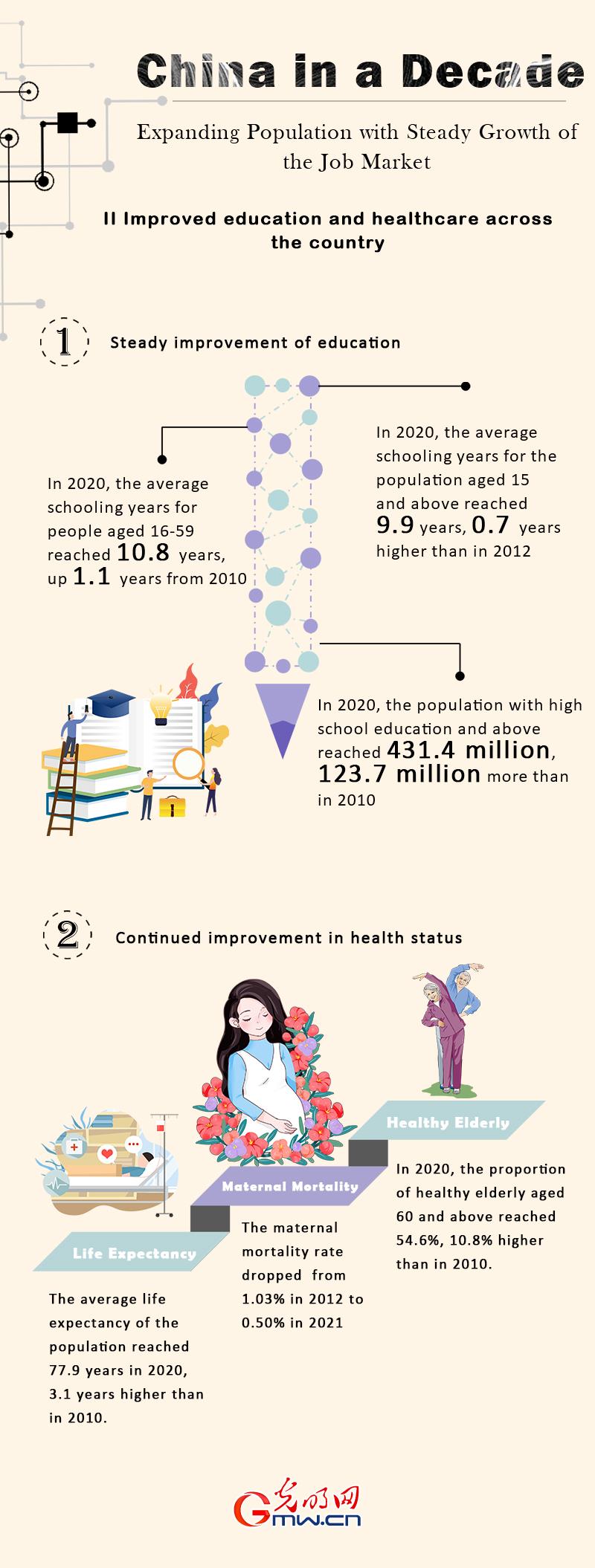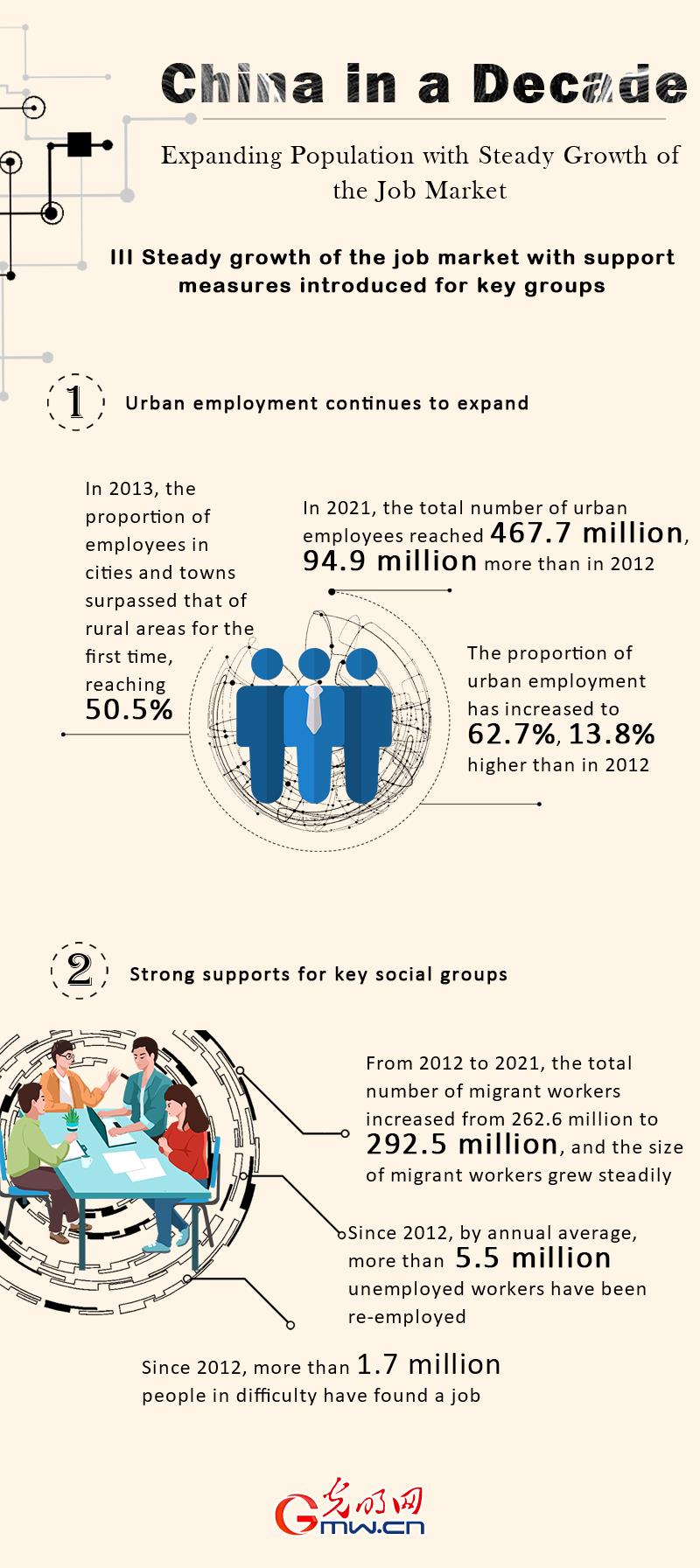China in a Decade: Expanding Population with Steady Growth of Job Market
Since the 18th Party Congress, the Party Central Committee with Comrade Xi Jinping at its core has followed the people-centered development philosophy and attached great importance to population and the job market. China actively adjusted its family planning policy, and its population has expanded with improved quality. Employment has been put at the center of China’s efforts in “ensuring stability on six key fronts and maintaining security in six key areas”. A slew of supportive measures were introduced to drive job growth, resulting in a steadily increasing number of the employed, and an optimized employment structure characterized by enhanced quality and overall stability.
I.Steady population growth with an accelerated trend of agglomeration

1. Population size keeps growing
In view of the declining fertility rate and aging population, the Party Central Committee with Comrade Xi Jinping as the core has coordinated population growth and economic development, introduced in 2013 the “two-child policy” for couples of which one partner is an only child, and then in 2016 the “universal two-child policy” was rolled out.
The policy went further relaxed in 2021, allowing a couple to have three children. Some additional supportive measures were carried out as well to promote the balanced growth of China’s population. The adjustment of the policy has met people’s diversified needs and increased the scale of newborns. From 2012 to 2021, an annual average of 16.2 million newborns were added to the Chinese population. At the end of 2021, China’s population reached 141.6 million, up 53.4 million from the end of 2012, with an average annual growth of 5.9 million and a growth rate of 0.4% each year.
2. Optimized gender structure
At the end of 2021, China’s male population was 723.1 million, accounting for 51.2%, and the female population was 689.5 million, accounting for 48.8%, with a general gender ratio of 104.9, down 0.2 from 2012. The gender structure of the population has improved significantly.
3. Population mobility is becoming increasingly active
Population mobility is an important indicator of population and social development. Since 2012, thanks to expanding urbanization, China’s population mobility has become increasingly active, injecting a strong impetus to the stable and healthy development of the economy and society. In 2020, 492.8 million people were living in a place different from their household registration site, accounting for 34.9% of the national population, of which the migrant population reached 375.8 million, accounting for 26.6% of the total population.
Population agglomeration of major city clusters has increased, with the population of the Guangdong-Hong Kong-Macao Greater Bay Area, the Yangtze River Delta and the Chengdu-Chongqing cluster growing rapidly by 35.0%, 12.0% and 7.3% respectively. Shanghai, Beijing, Guangdong and Zhejiang all have a population density increase of more than 100 people/km2 in 10 years.
II. Improved education and healthcare across the country

Since the 18th Party Congress, China’s education and healthcare have continued to develop with better quality and extended years of education, a longer life expectancy, and improved conditions in healthcare.
1. Steady improvement of education
Educational equity and quality have been strengthened over the years. China has promoted balanced compulsory education across its rural and urban areas, and advanced special education, continuing education, and vocational education, hence improving the overall level of education in the country. In 2020, the average schooling years for the population aged 15 and above reached 9.9 years, 0.7 years higher than in 2012. In 2020, the population with high school education and above reached 431.4 million, accounting for 30.6% of the total population, 123.7 million more than in 2010, up 7.6 percentage points. The average schooling years for people aged 16-59 reached 10.8 years, up 1.1 years from 2010, with 43.8% of the population educated in high school or above, an increase of 12.8 percentage points.
2. Continued improvement in health status
The “Healthy China Initiative” has gained continuous progress, with fitness venues and facilities significantly improving, mass sports events and activities flourishing, and expanding participation of the public in fitness activities.
The average life expectancy of the population reached 77.9 years in 2020, 3.1 years higher than in 2010.
The maternal mortality rate and infant mortality rate both dropped significantly, from 24.5/100,000 and 10.3‰ in 2012 to 16.1/100,000 and 5.0‰ in 2021, respectively, and the neonatal mortality rate dropped from 6.9‰ in 2012 to 3.1‰ in 2021.
The health status of the elderly has improved with the elderly accounting for a higher proportion in population. In 2020, the proportion of healthy elderly aged 60 and above reached 54.6%, 10.8 percentage points higher than in 2010.
III. Steady growth of the job market with support measures introduced for key groups

Since the 18th Party Congress, China has put employment at the center of its efforts in “ensuring stability on six key fronts and maintaining security in six key areas”. A slew of supportive measures are introduced to drive steady growth of the job market.
1. Urban employment continues to expand
China’s economy has registered a record high total volume characterized by quality growth and a new development pattern. New job drivers keep emerging, laying a solid foundation for stabilizing and expanding employment.
With the accelerated pace of urbanization, a great number of rural laborers have moved to the cities and towns where the job market has kept a growing momentum. In 2013, the proportion of employees in cities and towns surpassed that of rural areas for the first time, reaching 50.5%.
In 2021, the total number of urban employees reached 467.7 million, 94.9 million more than in 2012, with an average annual growth of 10.5 million. The proportion of urban employment has increased to 62.7%, 13.8 percentage points higher than in 2012, with an average annual increase of 1.5 percentage points.
2. Unemployment rate is kept within a reasonable range
Thanks to the synergy between economic growth and job growth, China’s labor market has basically achieved a balance between demand and supply.
In 2018 and 2019, the surveyed urban unemployment rate was kept at a low level of around 5.0%. The labor market borne the brunt of the Covid-19 pandemic in early 2020, with unemployment rising to 6.2% in February. Facing severe and complex domestic and international challenges, China has coordinated Covid-19 containment and socio-economic growth through a series of policy measures.
With the economy recovering and various measures taking effect, the urban unemployment rate started to fall, dropping to 5.2% in December 2020, down to the same level as the same period in 2019, and falling to 5.1% in December 2021.
3. Strong supports for key social groups
China has combined market-oriented approaches and government assistance measures to expand employment, alleviate structural problems, and provide strong support for key social groups.
From 2012 to 2021, the total number of migrant workers increased from 262.6 million to 292.5 million, and the size of migrant workers grew steadily. Since 2012, by annual average, more than 5.5 million unemployed workers have been re-employed, more than 1.7 million people in difficulty have found a job, and about 50,000 zero-employment households now have at least one member of the family employed.
IV. Economic transformation has optimized the employment structure

Since 2013, driven by economic transformation and upgrading, the supply-side structural reform and high-quality development, new industries and business models have quickly emerged, China’s employment structure has optimized, and the overall skills of the employed have been enhanced.
1. Three Industries has driven remarkable job growth
In 2021, the number of employed in primary, secondary and tertiary industries in China reached 170.7 million, 217.1 million and 358.7 million respectively, accounting for 22.9%, 29.1% and 48.0% respectively.
2. New economy drives employment significantly
With the new round of technological revolution and the vigorous growth of the digital economy, new industries and new business models are giving birth to new jobs such as big data engineers and technicians, drone pilots, delivery workers and E-commerce marketing professionals.
In 2020, the number of employees in China’s share economy reached 6.31 million, about 1.3 million more than in 2015, and sharing economy platforms provided 84 million jobs, about 34 million more than in 2015.
3. The quality of employees is significantly improved
The rapid development of education has led to steady optimization of the educational structure of employees in China, providing an abundance of highly qualified talents to the labor market. In 2020, the average schooling years of employees increased from 9.7 in 2012 to 10.4 years in 2020. China’s talent team has expanded continuously, with a total of 187,000 people enjoying special government allowances nationwide by the end of 2021, 20,000 more than in 2012. The Hundred Million Strong Program now has more than 6,500 talents at the state level, an increase of more than 2,400 against 2013. A total of 39.4 million people nationwide hold various types of professional and technical qualifications, an increase of 23.6 million.
V. Greater social security and steady improvement of employment quality

Since the 18th Party Congress, China has followed a new development approach and created a new development pattern. Through high-quality employment, the country has better served people’s aspiration for a better life, and an increasing number of employees are sharing the fruits of China’s social and economic development.
1. Wage income keeps growing
Driven by continuous growth of China’s economy, a minimum wage mechanism was established, and the income distribution structure has been optimized. Workers’ wage income has grown steadily, and their sense of satisfaction has been significantly enhanced. In 2021, the average annual wage of employees in urban non-private agencies reached 106,837 yuan, 1.3 times higher than in 2012, with an average annual growth of 9.6% since 2013; the average wage of urban employees in the private sector reached 62,884 yuan, 1.2 times higher than in 2012, with an average annual growth rate of 9.1%.
2. The employment of enterprises has become more standardized
China has continuously improved relevant laws and regulations, rectified the order of the labor market, strengthened supervision over labor law enforcement, and vigorously cracked down on wage arrears. China has maintained the vitality of the labor market and protected the legitimate rights and interests of workers. In 2021, a total of 1.3 million collective employment contracts were submitted to human resources and social security departments for review, involving a total of 120 million workers. China’s labor regulatory authorities at all levels filed and investigated 63,000 cases of wage violations and recovered 5.65 billion yuan wage arrears and other benefits for 450,000 migrant workers.
3. Gradual strengthening of labor security
The 18th Party Congress vowed to build a moderately prosperous society where all are covered by social security. China has continued to increase financial investment and reform efforts, built the world’s largest social security system, and significantly increased the coverage of various social insurances. At the end of 2021, the number of urban workers covered by basic pension insurance reached 48.1 million, an increase of 176.5 million over the end of 2012. A total of 354.3 million employees were covered by basic medical insurance, an increase of 89.5 million people against the end of 2012.
